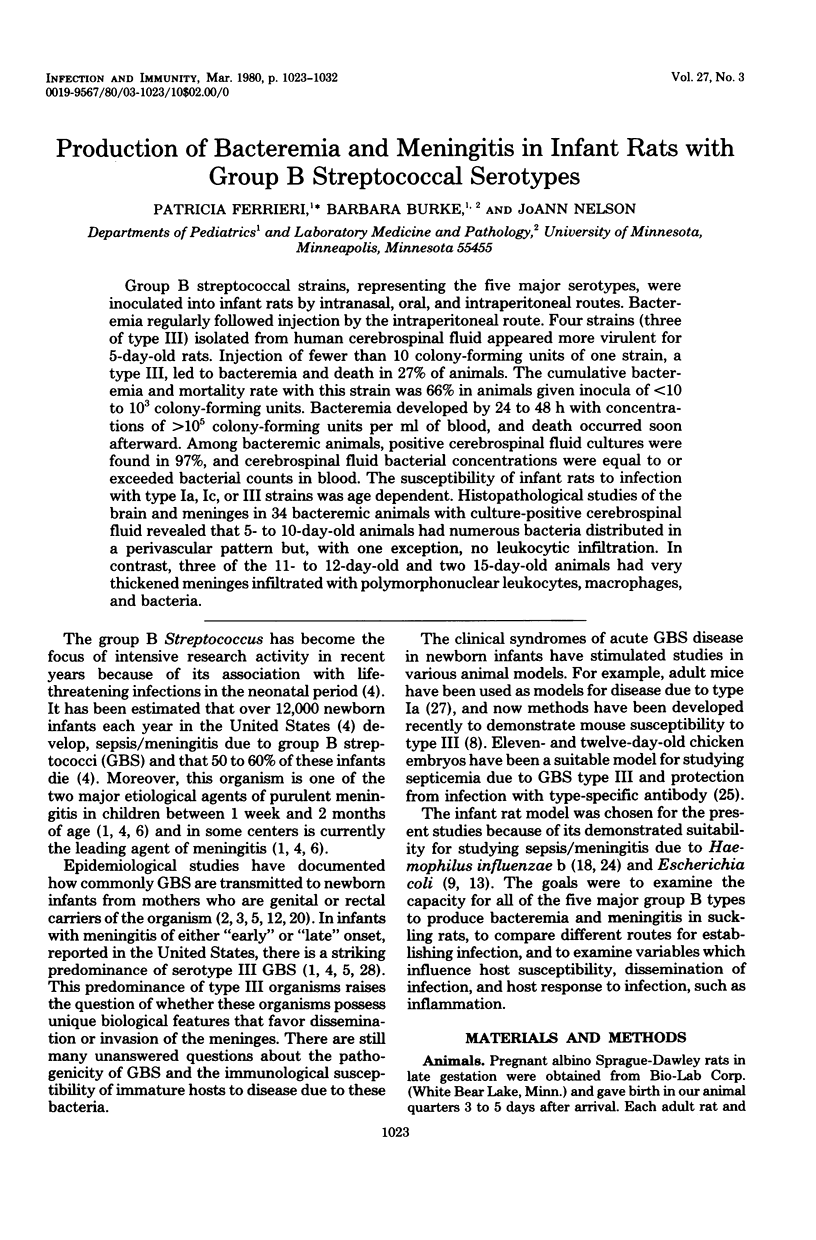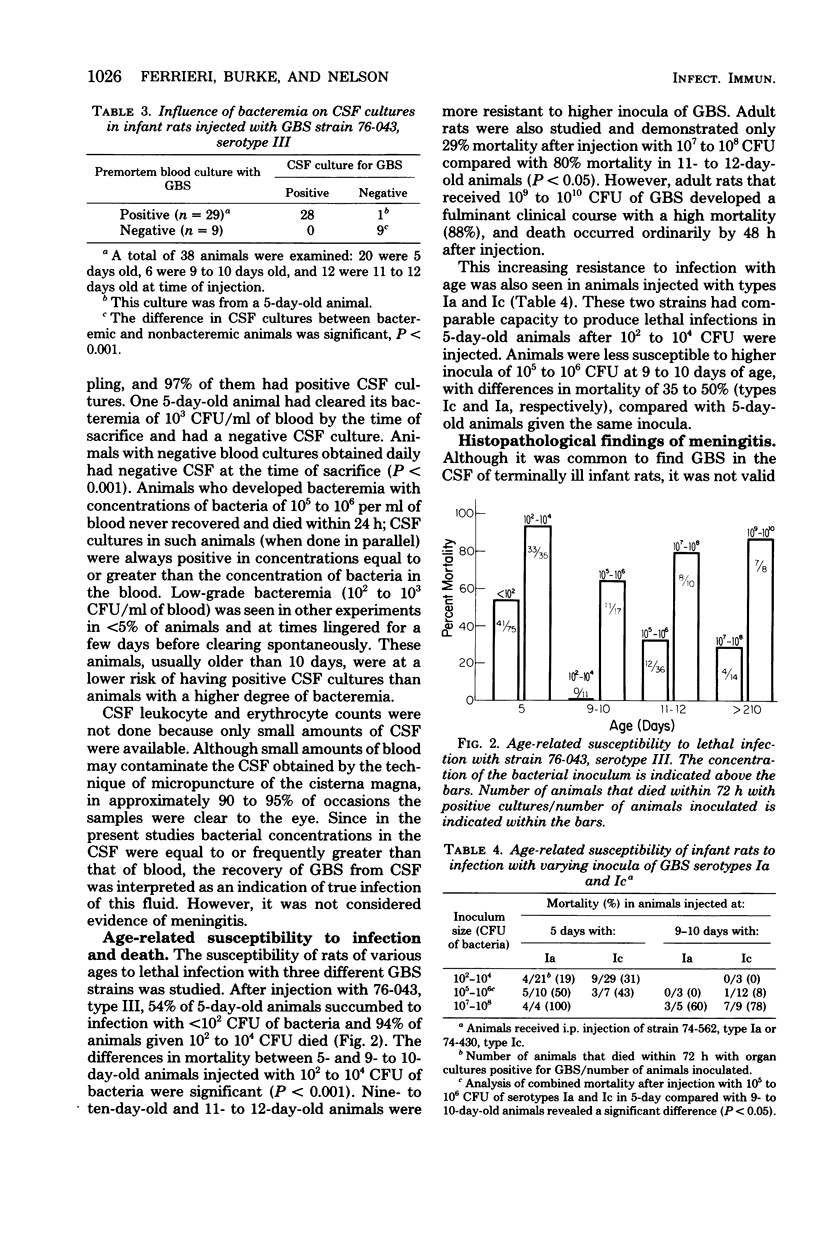Abstract
Group B streptococcal strains, representing the five major serotypes, were inoculated into infant rats by intranasal, oral, and intraperitoneal routes. Bacteremia regularly followed injection by the intraperitoneal route. Four strains (three of type III) isolated from human cerebrospinal fluid appeared more virulent for 5-day-old rats. Injection of fewer than 10 colony-forming units of one strain, a type III, led to bacteremia and death in 27% of animals. The cumulative bacteremia and mortality rate with this strain was 66% in animals given inocula of less than 10 to 10(3) colony-forming units. Bacteremia developed by 24 to 48 h with concentrations of greater than 10(5) colony-forming units per ml of blood, and death occurred soon afterward. Among bacteremic animals, positive cerebrospinal fluid cultures were found in 97%, and cerebrospinal fluid bacterial concentrations were equal to or exceeded bacterial counts in blood. The susceptibility of infant rats to infection with type Ia, Ic, or III strains was age dependent. Histopathological studies of the brain and meninges in 34 bacteremic animals with culture-positive cerebrospinal fluid revealed that 5- to 10-day-old animals had numerous bacteria distributed in a perivascular pattern but, with one exception, no leukocytic infiltration. In contrast, three of the 11- to 12-day-old and two 15-day-old animals had very thickened meninges infiltrated with polymorphonuclear leukocytes, macrophages, and bacteria.
Full text
PDF









Images in this article
Selected References
These references are in PubMed. This may not be the complete list of references from this article.
- Anthony B. F., Okada D. M., Hobel C. J. Epidemiology of group B Streptococcus: longitudinal observations during pregnancy. J Infect Dis. 1978 May;137(5):524–530. doi: 10.1093/infdis/137.5.524. [DOI] [PubMed] [Google Scholar]
- Anthony B. F., Okada D. M. The emergence of group B streptococci in infections of the newborn infant. Annu Rev Med. 1977;28:355–369. doi: 10.1146/annurev.me.28.020177.002035. [DOI] [PubMed] [Google Scholar]
- Badri M. S., Zawaneh S., Cruz A. C., Mantilla G., Baer H., Spellacy W. N., Ayoub E. M. Rectal colonization with group B streptococcus: relation to vaginal colonization of pregnant women. J Infect Dis. 1977 Feb;135(2):308–312. doi: 10.1093/infdis/135.2.308. [DOI] [PubMed] [Google Scholar]
- Baker C. J., Barrett F. F., Gordon R. C., Yow M. D. Suppurative meningitis due to streptococci of Lancefield group B: a study of 33 infants. J Pediatr. 1973 Apr;82(4):724–729. doi: 10.1016/s0022-3476(73)80606-7. [DOI] [PubMed] [Google Scholar]
- Baker C. J., Barrett F. F. Transmission of group B streptococci among parturient women and their neonates. J Pediatr. 1973 Dec;83(6):919–925. doi: 10.1016/s0022-3476(73)80524-4. [DOI] [PubMed] [Google Scholar]
- Baltimore R. S., Kasper D. L., Baker C. J., Goroff D. K. Antigenic specificity of opsonophagocytic antibodies in rabbit anti-sera to group B streptococci. J Immunol. 1977 Feb;118(2):673–678. [PubMed] [Google Scholar]
- Baltimore R. S., Kasper D. L., Vecchitto J. Mouse protection test for group B Streptococcus type III. J Infect Dis. 1979 Jul;140(1):81–88. doi: 10.1093/infdis/140.1.81. [DOI] [PubMed] [Google Scholar]
- Bortolussi R., Ferrieri P., Wannamaker L. W. Dynamics of Escherichia coli infection and meningitis in infant rats. Infect Immun. 1978 Nov;22(2):480–485. doi: 10.1128/iai.22.2.480-485.1978. [DOI] [PMC free article] [PubMed] [Google Scholar]
- Feldman W. E. Concentrations of bacteria in cerebrospinal fluid of patients with bacterial meningitis. J Pediatr. 1976 Apr;88(4 Pt 1):549–552. doi: 10.1016/s0022-3476(76)80003-0. [DOI] [PubMed] [Google Scholar]
- Ferrieri P., Cleary P. P., Seeds A. E. Epidemiology of group-B streptococcal carriage in pregnant women and newborn infants. J Med Microbiol. 1977 Feb;10(1):103–114. doi: 10.1099/00222615-10-1-103. [DOI] [PubMed] [Google Scholar]
- Glode M. P., Sutton A., Moxon E. R., Robbins J. B. Pathogenesis of neonatal Escherichia coli meningitis: induction of bacteremia and meningitis in infant rats fed E. coli K1. Infect Immun. 1977 Apr;16(1):75–80. doi: 10.1128/iai.16.1.75-80.1977. [DOI] [PMC free article] [PubMed] [Google Scholar]
- Milligan T. W., Baker C. J., Straus D. C., Mattingly S. J. Association of elevated levels of extracellular neuraminidase with clinical isolates of type III group B streptococci. Infect Immun. 1978 Sep;21(3):738–746. doi: 10.1128/iai.21.3.738-746.1978. [DOI] [PMC free article] [PubMed] [Google Scholar]
- Moxon E. R., Ostrow P. T. Haemophilus influenzae meningitis in infant rats: role of bacteremia in pathogenesis of age-dependent inflammatory responses in cerebrospinal fluid. J Infect Dis. 1977 Feb;135(2):303–307. doi: 10.1093/infdis/135.2.303. [DOI] [PubMed] [Google Scholar]
- Moxon E. R., Smith A. L., Averill D. R., Smith D. H. Haemophilus influenzae meningitis in infant rats after intranasal inoculation. J Infect Dis. 1974 Feb;129(2):154–162. doi: 10.1093/infdis/129.2.154. [DOI] [PubMed] [Google Scholar]
- Quirante J., Ceballos R., Cassady G. Group B beta-hemolytic streptococcal infection in the newborn. I. Early onset infection. Am J Dis Child. 1974 Nov;128(5):659–665. doi: 10.1001/archpedi.1974.02110300069009. [DOI] [PubMed] [Google Scholar]
- Rotta J., Krause R. M., Lancefield R. C., Everly W., Lackland H. New approaches for the laboratory recognition of M types of group A streptococci. J Exp Med. 1971 Nov 1;134(5):1298–1315. doi: 10.1084/jem.134.5.1298. [DOI] [PMC free article] [PubMed] [Google Scholar]
- Shigeoka A. O., Hall R. T., Hill H. R. Strain specificity of opsonins for group B streptococci types II and III. Infect Immun. 1979 Feb;23(2):438–445. doi: 10.1128/iai.23.2.438-445.1979. [DOI] [PMC free article] [PubMed] [Google Scholar]
- Smith A. L., Smith D. H., Averill D. R., Jr, Marino J., Moxon E. R. Production of Haemophilus influenzae b meningitis in infant rats by intraperitoneal inoculation. Infect Immun. 1973 Aug;8(2):278–290. doi: 10.1128/iai.8.2.278-290.1973. [DOI] [PMC free article] [PubMed] [Google Scholar]
- Summary of the workshop on perinatal infections due to group B Streptococcus. J Infect Dis. 1977 Jul;136(1):137–152. doi: 10.1093/infdis/136.1.137. [DOI] [PubMed] [Google Scholar]
- Tieffenberg J., Vogel L., Kretschmer R. R., Padnos D., Gotoff S. P. Chicken embryo model for type III group B beta-hemolytic streptococcal septicemia. Infect Immun. 1978 Feb;19(2):481–485. doi: 10.1128/iai.19.2.481-485.1978. [DOI] [PMC free article] [PubMed] [Google Scholar]
- Wennerstrom D. E., Schutt R. W. Adult mice as a model for early onset group B streptococcal disease. Infect Immun. 1978 Feb;19(2):741–744. doi: 10.1128/iai.19.2.741-744.1978. [DOI] [PMC free article] [PubMed] [Google Scholar]
- Wilkinson H. W. Group B streptococcal infection in humans. Annu Rev Microbiol. 1978;32:41–57. doi: 10.1146/annurev.mi.32.100178.000353. [DOI] [PubMed] [Google Scholar]




